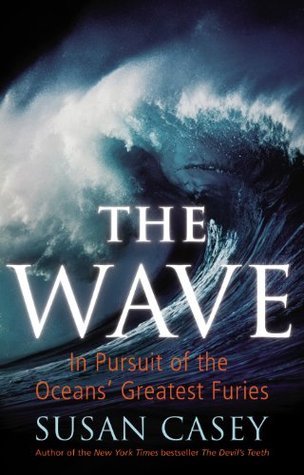What do you think?
Rate this book


434 pages, Kindle Edition
First published September 14, 2010
Emerging from the depths, [the underwater mountains that form the bank act] as one long trip wire for swells that have stampeded down from Alaska, focusing wave energy onto the bank like a giant magnifying glass. This refraction is so dramatic that when a swell hits Cortes under the right conditions, it can jack up to quadruple its size (meaning that a twenty-foot swell can churn out eighty-foot waves). The bank’s unique location, surrounded by abyssal waters and with nothing to buffer it from the full force of the open Pacific, made it a top candidate to produce not only a clean one-hundred-foot wave, but according to [wave-prediction expert Sean] Collins, “definitely a very good, rideable 150-footer.”Casey turned similar intense attention to the people who race toward, not away from, the Cortes Bank and areas like it: Laird Hamilton and his posse of extreme surfers. As expected, these surfers are capable and confident, laser-focused on their interest, which for them goes beyond a hobby to a way of life. They religiously follow weather reports and hop on planes immediately to catch waves moving up a coast. Sleep deprivation is par for the course. Hamilton and other seasoned extreme surfers aren’t arrogant, though. Despite his effortlessness on the waves, Hamilton knows that in a match between him and a giant wave, the wave always has the upper-hand. He’s experienced too many broken bones, concussions, and close calls (as have his friends) to think otherwise. He’s so aware of the ocean’s precariousness and power that he’s almost superstitious, refusing to make a prediction about how the next day’s waves will treat him. However, that reverence doesn’t soften the impression that extreme surfers are a foolhardy breed. Casey’s final portrait is of people addicted to the high they get when their brains are flooded with endorphins and oxytocin—natural opiates and biological relatives to heroin and morphine. Hamilton is obsessed, and he and his friends feel an insatiable urge to risk their lives regularly for no other reason than the thrill.
The force of waves is hard to overstate. An eighteen-inch wave can topple a wall built to withstand 125-mile-per-hour winds, for instance, and coastal advisories are issued for even five-foot-tall surf, which regularly kills people caught in the wrong places. The number of people who have witnessed a hundred-foot wave at close range and made it back home to describe the experience is a very small one.Casey says this on page eight, priming readers to feel full appreciation for the many surfing and historical anecdotes that follow. Told with especially good suspense is the part about the 1,740-foot tsunami that rose up out of Alaska’s Lituya Bay in July 1958 following an avalanche.
I heard it before I saw it, the exploding curtain of glass that hammered onto the reef, the lip of a thirty-foot barrel hitting the earth like a liquid apocalypse. From a visual standpoint, Teahupoo was a looker. Rich lapis, deep emerald, pale aquamarine—its waters were the color of jewels, and its heavy white crest glittered in the sun. But even though the wave was gorgeous, it had the personality of a buzz saw.Her descriptions are the next best thing to actually seeing these waves; nevertheless, the book’s eight pages of dramatic photos are a necessary addition. Although she asks readers to process a lot of information, Casey wrote clearly and had an obvious main idea: The ocean is powerful and capricious. Much remains a mystery. It doesn’t seem to like rules, and both playing in it and studying it require respect and humility.